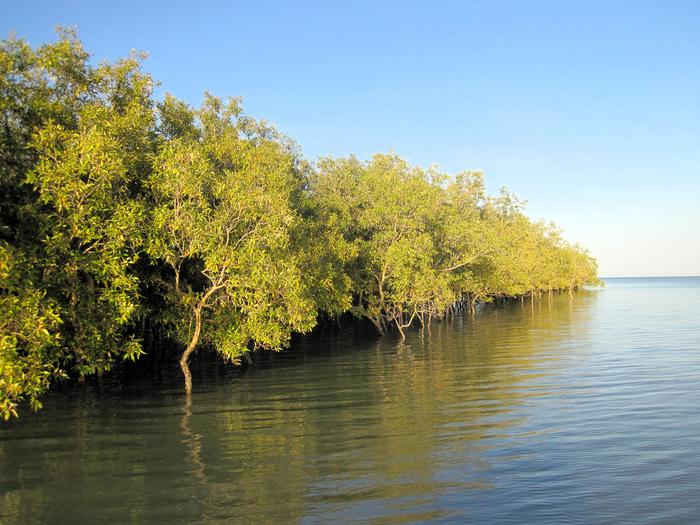South Florida homeowners are willing to open their wallets for climate protection—but they’d rather pay for mangrove forests than concrete barriers.
A new University of Miami study reveals that residents strongly favor nature-based coastal defenses, with green infrastructure projects delivering more than double the economic bang for the buck compared to traditional seawalls. The research, which surveyed 850 households across Miami-Dade, Broward, and Palm Beach counties, found that residents would pay an average of $61 to $63 more per household annually for mangrove and coastal dune projects than for seawalls.
The Numbers Tell a Green Story
When researchers crunched the economics, the results were striking. For a hypothetical 10-mile mangrove project lasting 50 years, residents’ collective willingness to pay reached $1.08 billion—nearly four times the estimated $230 million construction cost. That translates to a benefit-cost ratio of 4.7, compared to just 2.0 for seawalls.
“What I found is that all the projects pass what we call the cost-benefit analysis, which means the aggregate benefits will outweigh the cost,” said Haoluan Wang, assistant professor of sustainable economics who led the study. “Then, if we put those numbers into context, what I found is that green infrastructure will have a higher benefit-cost ratio compared to gray infrastructure.”
The preference isn’t just about dollars and sense. Coastal dunes and beach renourishment projects scored the highest benefit-cost ratio at 5.64, while traditional seawalls lagged behind at 2.02.
Why Green Beats Gray
The appeal of living seawalls makes intuitive sense. Mangrove forests don’t just block storm surge—they provide wildlife habitat, sequester carbon, and attract tourists. Salt marshes filter water while offering recreational opportunities. Beach renourishment creates the kind of coastline that draws visitors to Florida in the first place.
Traditional seawalls, by contrast, offer protection but little else. They’re purely functional barriers that can actually accelerate erosion on adjacent beaches.
Survey responses reflected this multifaceted value. Overall, residents supported roughly 64% of proposed climate adaptation projects, with green infrastructure receiving the highest approval rates. Mangrove projects earned support from 67% of respondents, while seawalls managed just 62%.
The Flood Factor
Geography shaped preferences in predictable ways. Residents living within 100-year floodplains showed significantly higher willingness to pay for protection projects—a logical response given their elevated risk exposure.
Interestingly, risk-averse individuals actually showed lower support for adaptation projects, possibly reflecting broader climate skepticism among this group.
Key Findings from the Study:
- All three infrastructure types proved economically viable with benefits exceeding costs
- Green infrastructure benefit-cost ratios more than doubled those of gray infrastructure
- Residents would pay $106.80 annually for basic seawall protection
- Project lifespan directly correlates with cost-effectiveness—longer projects deliver better returns
Real-World Implications
The research arrives as South Florida grapples with accelerating sea level rise. Projections suggest water levels could climb 6-10 inches by 2030 and 14-26 inches by 2060 across the three-county region.
Local governments have already begun incorporating these findings into planning. Miami-Dade County revised its Climate Action Strategy in 2021 to emphasize marsh and mangrove restoration, while Broward County outlined strategies for community-wide hazard mitigation programs.
“According to this study, local governments can increase property taxes by a certain level and let the residents know the increase will be used for implementing these projects, and people are fine with that,” Wang noted.
The Equity Question
Yet the research also highlights potential pitfalls. Climate gentrification concerns loom large as infrastructure investments could disproportionately benefit wealthier coastal neighborhoods where property values—and tax revenues—run highest.
The study found significant demographic variations in support levels. Familiarity with adaptation strategies strongly predicted higher willingness to pay, raising concerns about community engagement across different populations.
What’s the path forward? The data suggests policymakers should prioritize green infrastructure while ensuring equitable implementation across communities. As sea levels continue rising, the question isn’t whether South Florida needs coastal protection—it’s whether leaders will choose solutions that work with nature rather than against it.
The study appears in the Journal of Environmental Management, representing one of the first comprehensive economic analyses comparing different coastal adaptation approaches in a real-world policy context.
If our reporting has informed or inspired you, please consider making a donation. Every contribution, no matter the size, empowers us to continue delivering accurate, engaging, and trustworthy science and medical news. Independent journalism requires time, effort, and resources—your support ensures we can keep uncovering the stories that matter most to you.
Join us in making knowledge accessible and impactful. Thank you for standing with us!

